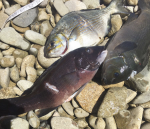I received the following regarding fish in California and gave a response —
From Zacha M —
Subject: Query about Khypphosus
Dear Ken Jones,
My name is Zacha and I am from the Canary Islands. I have been fishing since I was 6 years old. Fishing is my passion, especially the ISO float technique.
I would like to thank you for your blog, "Pier fishing in California". I find it an excellent guide. I've only been in California for 4 months, so here, everything is new to me. The blog has been a great help to me and I consult it frequently. I can only congratulate you.
I also want to use this email, to make an inquiry, if you allow me. The query is about the fish of the "Khypphosus" family, colloquially known as "Bahamas chub", "Silver Drummer" in Australia, or "Chopa perezosa" in my island. This has been my forever preferred target fish for ISO fishing due to its large size, combat strength, and difficulty catching it. (I would like to send you a photo of my best catch of this fish, but I have not found your email address on the internet).
My question is, does this fish exist on the California coast? I have asked more than 7 fishermen, including owners of fishing shops, and they have all said NO.
However, I know how shy these fish can be, and how difficult it is to catch them from the shore, so that answer did not make me throw in the towel.
I know these fish exist in all of the world's warm oceans, so it could be logical to think, that this fish does not exist in waters further north of Monterrey, and perhaps is in the middle or southern part of California.
But what was my surprise when I visited the San Francisco science museum, where in their aquarium they have a large Kyphosus of about 15 pounds. I think it is a Kyphosus sectatrix.
Why does the San Francisco science museum have this fish? I think that museums of this type normally try to show the species that live in its coasts, so, why has no fisherman seen that fish?
Perhaps you, as an expert fisherman with extensive experience, can answer this question.
Thanks for your time in reading my email.
Dear Mr. M,
I have not found any reference to the fish you mention being caught in California. There are however three closely related fish:
The Zebraperch, Kyphosus azureus, is a commonly caught fish in southern California and Baja and ranges from the Klamath River estuary to the Gulf of California.
The Blue-Bronze Chub, Kyphosus vaigiensis, has been taken from near Monterey, in central California, to northern Chile but is rare in California.
The Bluestriped Chub, Kyphosus ocyurus, has been recorded from Diablo Canyon in central California to Peru but is rare in California.
That's the best I can do.
Best wishes, Ken
From Zacha M —
Subject: Query about Khypphosus
Dear Ken Jones,
My name is Zacha and I am from the Canary Islands. I have been fishing since I was 6 years old. Fishing is my passion, especially the ISO float technique.
I would like to thank you for your blog, "Pier fishing in California". I find it an excellent guide. I've only been in California for 4 months, so here, everything is new to me. The blog has been a great help to me and I consult it frequently. I can only congratulate you.
I also want to use this email, to make an inquiry, if you allow me. The query is about the fish of the "Khypphosus" family, colloquially known as "Bahamas chub", "Silver Drummer" in Australia, or "Chopa perezosa" in my island. This has been my forever preferred target fish for ISO fishing due to its large size, combat strength, and difficulty catching it. (I would like to send you a photo of my best catch of this fish, but I have not found your email address on the internet).
My question is, does this fish exist on the California coast? I have asked more than 7 fishermen, including owners of fishing shops, and they have all said NO.
However, I know how shy these fish can be, and how difficult it is to catch them from the shore, so that answer did not make me throw in the towel.
I know these fish exist in all of the world's warm oceans, so it could be logical to think, that this fish does not exist in waters further north of Monterrey, and perhaps is in the middle or southern part of California.
But what was my surprise when I visited the San Francisco science museum, where in their aquarium they have a large Kyphosus of about 15 pounds. I think it is a Kyphosus sectatrix.
Why does the San Francisco science museum have this fish? I think that museums of this type normally try to show the species that live in its coasts, so, why has no fisherman seen that fish?
Perhaps you, as an expert fisherman with extensive experience, can answer this question.
Thanks for your time in reading my email.
Dear Mr. M,
I have not found any reference to the fish you mention being caught in California. There are however three closely related fish:
The Zebraperch, Kyphosus azureus, is a commonly caught fish in southern California and Baja and ranges from the Klamath River estuary to the Gulf of California.
The Blue-Bronze Chub, Kyphosus vaigiensis, has been taken from near Monterey, in central California, to northern Chile but is rare in California.
The Bluestriped Chub, Kyphosus ocyurus, has been recorded from Diablo Canyon in central California to Peru but is rare in California.
That's the best I can do.
Best wishes, Ken

